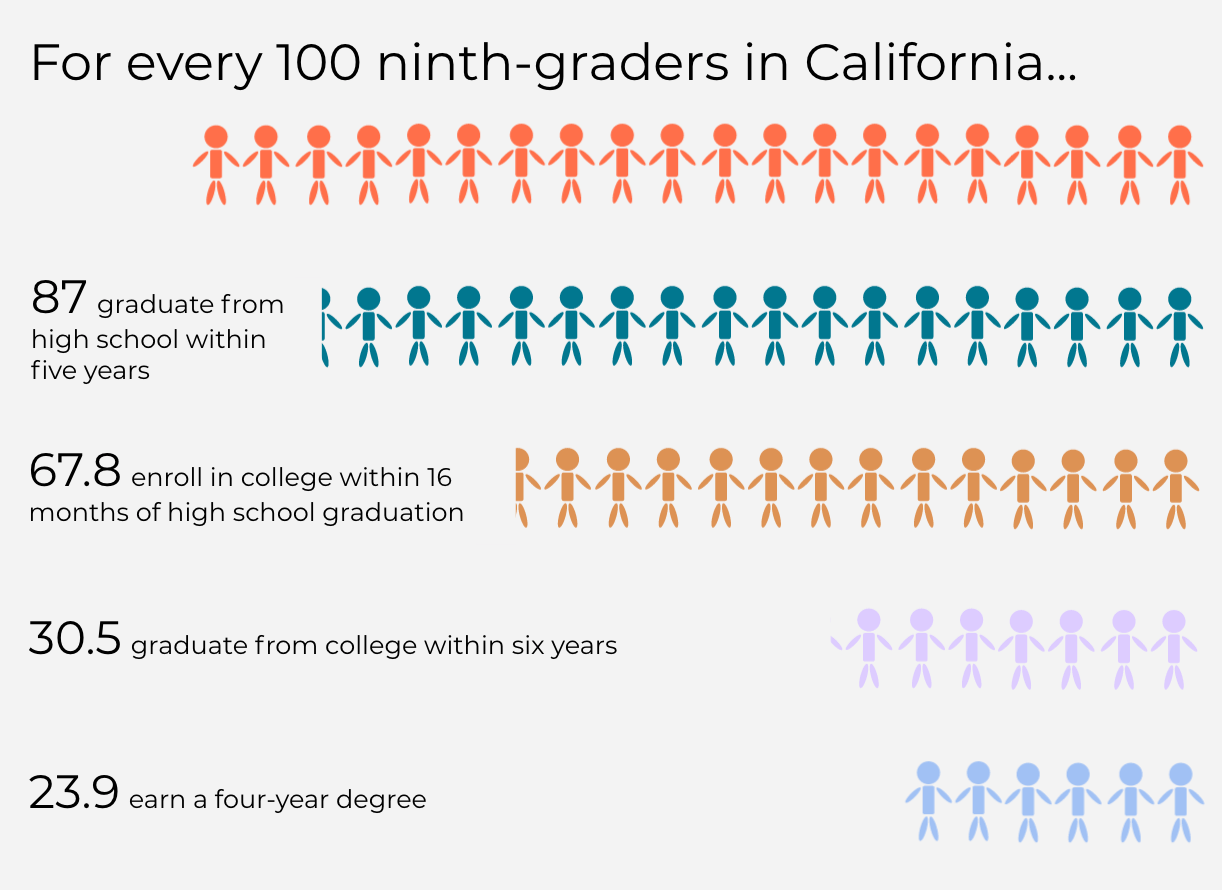
Education is a journey on a road with many exits.
In This Lesson
What are the life outcomes of California students?
What is California’s Master Plan for Higher Education?
How many students are enrolled in private colleges in California?
How does adult education work in California?
How is adult education funded in California?
What is the GED? How many take it? How many pass?
Why do so many students enroll but not earn a degree?
What are the requirements to attend college in California?
★ Discussion Guide
We hope that all students persist through high school, but many do not. We hope that many go on to college, but many do not. We hope those who go to college will finish, but, again, many do not.
California has a long and well-respected history of providing its residents with affordable, lifelong access to postsecondary education. The largest and most visible investment is a robust public system of colleges and universities.
For every 100 students that enter 9th grade this year in California, about 87 will finish high school within five years. About 68 will enroll in some kind of college, but only 30 will earn a degree within six years. About 24 of those will be four-year degrees, and 6 will be two-year degrees.
 Source: Ed100 analysis of available California and national data, 2021, by Sam Hiken and Jeff Camp. Rates of high school graduation, college enrollment, and college completion have risen significantly over time. Compare this graphic to 2006).
Source: Ed100 analysis of available California and national data, 2021, by Sam Hiken and Jeff Camp. Rates of high school graduation, college enrollment, and college completion have risen significantly over time. Compare this graphic to 2006). There are important patterns, of course. Female students tend to advance to and through college at higher rates than male students. Race/ethnicity is predictive, too — explore the interactive chart below to see Ed100's analysis of current trends.
California’s Master Plan for Higher Ed: three college systems
California's system of public higher education has three parts. In 1960, California's Master Plan for Higher Education created three systems of public colleges that still exist today. All three systems depend heavily on the state for funding to subsidize the California students who attend.
Big: The University of California (UC) system is the state’s primary academic research institution. It provides undergraduate, graduate, and professional education to over 280,000 students at ten campuses. Admission is guaranteed to the top 12.5% of public high school graduates and all qualified community college transfer students.
Bigger: The California State University (CSU) system has a total of 23 campuses and serves over 400,000 students. The CSU offers undergraduate and graduate education, including a limited number of doctorate degrees jointly with the University of California. Admission to the CSU is available to the top one-third (33.3%) of public high school graduates and all qualified community college transfer students.
Biggest: The California Community Colleges (CCC) is this country’s largest system of higher education. The 116 campuses are organized into 72 districts that together serve 2.1 million students of all ages. About three out of every 10 high school graduates -- that’s over 100,000 students annually -- enroll in a community college and study alongside many older adults. Students who attend community colleges can earn an associate degree, complete a training or certificate program, or prepare to transfer to a four-year university. California's community colleges accept all applicants who are high school graduates, as well as any other adults who can benefit from attendance.
Historically, these three systems operated very separately, and transfer applications were a painful process. In 2015 the leadership of the CSU system began to define explicit pathways for transfers. The UC system clarified its transfer processes and requirements in 2018.
More extensive information about these public institutions, the students they serve, and issues they face is available in a series of concise briefs from The Campaign for College Opportunity. Private colleges in California also play a significant role, enrolling nearly 300,000 students.
Adult Education programs in California
California’s adult education system also provides a second chance to young adults who have not graduated from high school.
At the time that California passed its Master Plan for higher education, the state also provided significant funding to public high schools and community colleges to provide adult education classes. The basic reason for an investment in adult education investment is economic; the state’s adults need access to continuing education of various sorts, not necessarily tied to the completion of a degree or certificate.
Funding for adult education declined by over 50% during the Great Recession, spurring California officials to begin rethinking the state’s approach. Spearheaded by Governor Jerry Brown, lawmakers called for a transition to a system of regional partnerships for this purpose. In 2013 the state budget agreement stabilized adult ed funding and set a two-year timeline for the implementation of these partnerships.
Today, though funding for adult education has been greatly reduced, about one million adult students per year still enroll in adult education courses through public schools, community colleges, and various community providers. Over a third of these adult students are studying English as a second language, with the support of federal funding.
One important goal of California’s adult education system is to give a second chance to young adults who have not graduated from high school. For example, the system offers students classes to prepare for the General Educational Development (GED®) test or the HiSET®. In 2017, 300,540 Americans took the GED test, and 79 percent passed.
What comes after high school for your student?
The California State PTA provides resources to help plan for college, including info on application and testing assistance, school research, and financial aid.
- University of California entrance requirements
- California State University entrance requirements
- California Community College entrance requirements
Updated August 2021
CHAPTER 9:
Success
-
Success
Overview of Chapter 9 -
Measures of Success in Education
For Kids and For Schools -
Student Success
How Well is My Kid Doing in School? -
Standardized Tests
How Should We Measure Student Learning? -
College Readiness
Preparing Students for College and Career -
Education Data in California
Keeping Track of the School System -
Achievement Gaps
The Education System's Biggest Challenge -
The California School Dashboard
Measuring California School Performance -
College in California
Options After High School -
Paying for College in California
Are College Loans Good For Students?
Related
-
Education and the Economy
Schools for Knowledge Work -
Is School Challenging Enough?
Academic Rigor -
Why Are Tests Important?
Why Tests Matter and How They Work -
Student Success
How Well is My Kid Doing in School? -
College Readiness
Preparing Students for College and Career -
Paying for College in California
Are College Loans Good For Students?
Sharing is caring!
Password Reset
Search all lesson and blog content here.
Login with Email
We will send your Login Link to your email
address. Click on the link and you will be
logged into Ed100. No more passwords to
remember!














Questions & Comments
To comment or reply, please sign in .
Carol Kocivar November 30, 2025 at 5:57 pm
Colleges ease the dreaded admissions process as the supply of applicants declines
Prospective college students are finding no-fee and one-click applications — and higher acceptance rates.
https://hechingerreport.org/colleges-ease-the-dreaded-admissions-process-as-the-supply-of-applicants-declines
Carol Kocivar November 4, 2025 at 5:06 pm
Carol Kocivar November 4, 2025 at 4:37 pm
From California Competes in 2025:
"College remains one of the most reliable paths to upward mobility, but its economic return isn’t shared equally. New research finds that the return on investment (ROI) in higher education differs along lines of race, ethnicity, and sex, highlighting where targeted action is needed to make higher education a true engine of opportunity for all Californians."
Bachelor’s degrees: 78% of graduates achieve a positive ROI, but returns vary across groups.
White and Asian graduates (79-82%) are more likely to see a positive return than Black and Latinx graduates (73-77%).
Jeff Camp - Founder May 9, 2025 at 10:11 am
Carol Kocivar December 30, 2024 at 1:39 pm
The San Francisco Chronicle offers tools on undergraduate acceptance rates, data on every UC and CSU, and college counselors’ tips tailored just for getting into the Golden State’s prestigious public colleges.
https://www.sfchronicle.com/projects/california-college-admissions/?sid=5476a23c3b35d0d7548d6c87&ss=A&st_rid=691b11ea-bead-478f-8011-d686d61470f2&utm_source=newsletter&utm_medium=email&utm_term=briefing&utm_campaign=sfcn%20%7C%20bay%20briefing
Carol Kocivar December 6, 2023 at 3:00 pm
About three in five Californians enroll in college just after high school.
⊲ Recent data show that just over 62% of the 435,000 students who graduated from high school in spring 2020 enrolled in college within 12 months, down from a recent peak of 67% in 2017–18.
⊲ Enrollment rates are below average for low-income (54%) and English Learner students (42%). Just over half (55%) of Black and Latino graduates enrolled in college, compared to 68% of white students and 86% of Asian students. Women (nearly 68%) are significantly more likely to enroll than men (57%).
⊲ College enrollment rates were highest among graduates from the Bay Area (72%), and lowest in the Inland Empire and San Joaquin Valley (53%). Southern California (67%), the Central Coast (also 67%), and the far north (59%) were close to the statewide average.
https://www.ppic.org/wp-content/uploads/college-access-in-california.pdf
Carol Kocivar March 27, 2023 at 6:06 pm
https://www.sfchronicle.com/projects/2023/uc-admissions-acceptance-rates/
Carol Kocivar January 28, 2023 at 10:22 pm
Mean high school and transfer GPA are presented for freshman and transfer applicants, admits, and enrollees respectively by source school.
You an find it here: https://www.universityofcalifornia.edu/about-us/information-center/admissions-source-school
Jenny Greene August 13, 2020 at 3:54 pm
Jamie Kiffel-Alcheh December 7, 2019 at 4:02 pm
vandrm February 6, 2020 at 4:17 pm
Susannah Baxendale March 28, 2019 at 10:35 am
Jeff Camp August 9, 2018 at 2:47 pm
Carol Kocivar April 8, 2018 at 11:42 am
West Ed has published profiles of the College Promise in California that highlight important strategies.
Find out more
g4joer6 April 22, 2015 at 11:41 pm
Caryn-C September 18, 2017 at 10:44 am
Brenda Etterbeek June 15, 2019 at 2:12 pm